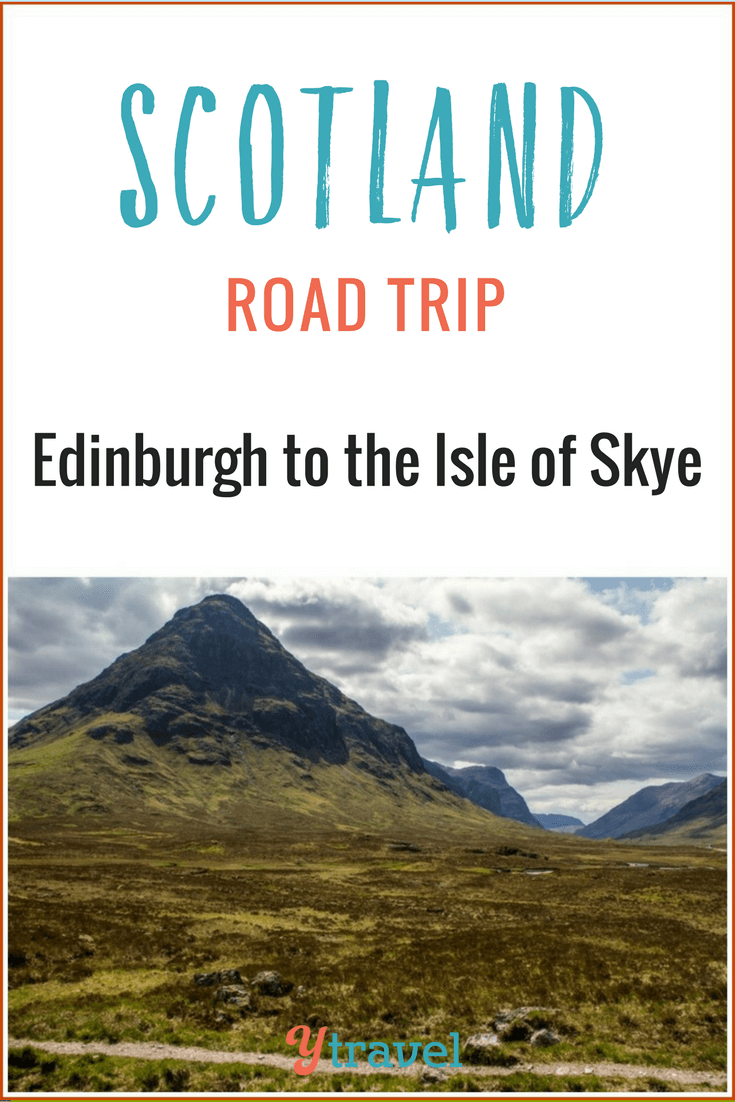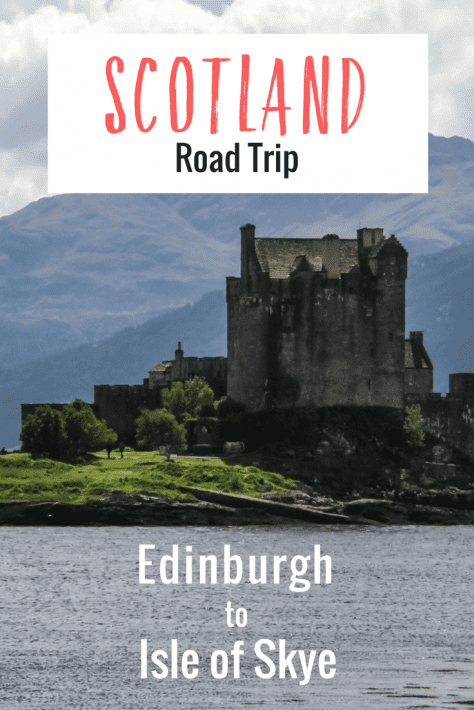This post may contain affiliate links. We may receive a small commission, at no cost to you, if you make a purchase. Read Disclosure.
One of the most beautiful road trips in Scotland you can do is driving from Edinburgh to the Isle of Skye.
The scenic drive passes through some of the most beautiful nature and iconic destinations in Scotland, so you definitely don’t want to drive it all in one hit.
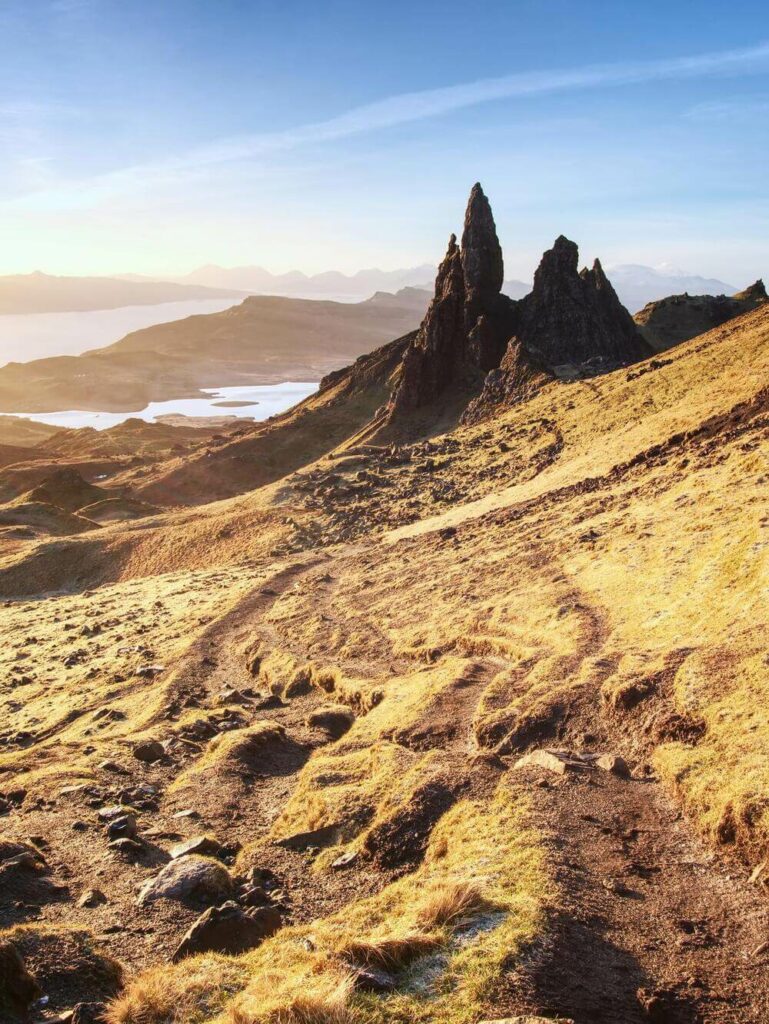
From the hilly and historical capital of Scotland, Edinburgh, the drive takes you past the scenic Glencoe area, and all the way to one of the most beautiful islands in the world, Skye,
Although most people know the NC 500 as the most beautiful drive in Scotland, that route has become over saturated with tourists its lost its charm – so for a less crowded road trip, check out this Edinburgh to Isle of Sky itinerary instead.
Below we share how you can take a road trip from Edinburgh to the Isle of Skye, Scotland and highlight all the top attractions you see along the way, plus shared accommodation recommendations and places to eat.
How much time should you allow to drive from Edinburgh to the Isle of Skye?
The drive from Edinburgh to the Isle of Skye (Portree) will take you 6 hours if driving via the Trossachs and Glencoe without stopping.
Although the drive can be completed in several hours, there are seven of the most beautiful stops along the way that will make you fall in love with Scotland.
You absolutely must stop at these attractions along the way. You could spend several hours in the Trossachs National Park, or you could spend several days, the duration is entirely down to you and your availability.
However, we would suggest allowing for 3-4 full days to travel from Edinburgh to Isle of Skye, and after this, you can explore more of the Isle of Skye.
This amount of time will allow you plenty of time to see the highlights at the stops along the way.
The Perfect Edinburgh to Isle of Skye Road Trip Itinerary
Now you know how much time to set aside, let’s take a look at the route you would take from Edinburgh to the Isle of Skye using the map below.
The best way to get from Edinburgh to Isle of Skye is via road trip. If you don’t have a car, you can hire a car here through DiscoverCars.com.
You may wish to start from the Isle of Skye and work backwards. If you do this, you can catch a train from Edinburgh to Inverness, and then take the The Kyle of Lochalsh line from Dingwall to Kyle of Lochalsh, and then a ferry over to the Isle of Skye.
It’s more effort to get to the Isle of Skye without a car, which is why we recommend driving from Edinburgh to the Isle of Skye and then doing a loop back again.
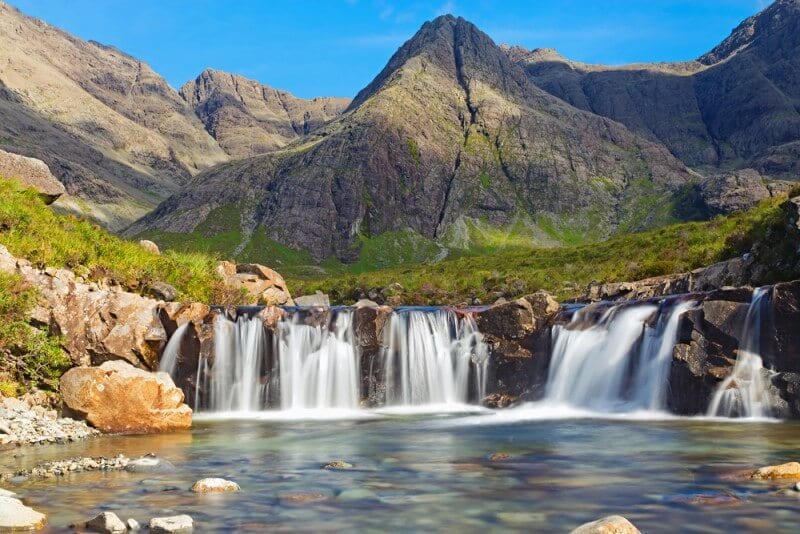
In the following itinerary, we will drive from Edinburgh to the Isle of Skye, and then drive back via Inverness and the Scottish Highlands.
The section between Edinburgh and Inverness has more than a few great places to stop off at as well, which we’ll mention below, but it’s totally up to you and your time frame whether you do this.
Don’t just rush through this scenic drive! Be sure to take a break and admire the following stops on the way to Isle of Skye from Edinburgh…
Stop 1: Edinburgh
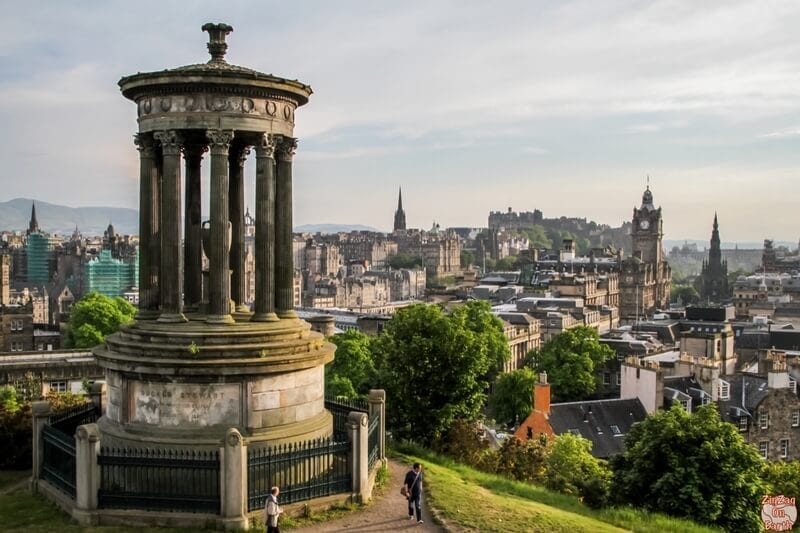
As you start your travels in Edinburgh, I recommend spending some time in the city. You need at least 2-3 days to enjoy Edinburgh as there’s so much to see and do.
If you arrive in Edinburgh one evening and plan to set off the next day, spend your limited time in Edinburgh at Calton Hill, especially at sunset, where you can admire unobstructed views of the old town, Royal Mile and Edinburgh Castle, and the volcanic Arthur’s Seat.
Locals and tourists alike (and wedding photographers) come to enjoy one of the most beautiful views in the country.
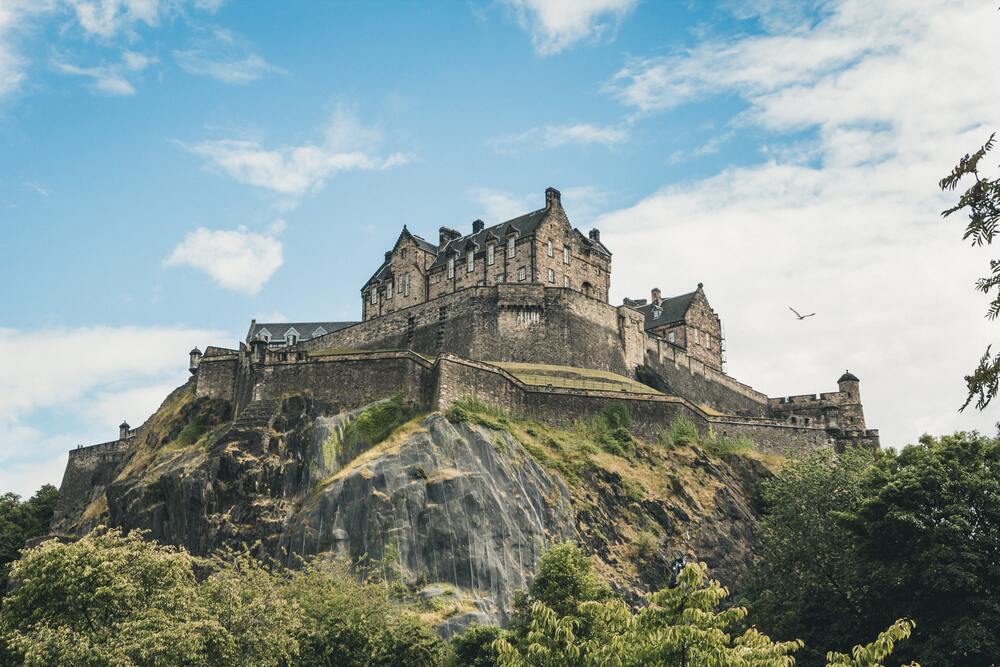
If you have a few days to spend in Scotland’s enchanting capital, don’t miss out on a chance to explore the towering Edinburgh Castle, perched atop an ancient volcano.
Spend time wandering down The Royal Mile, a stunning thoroughfare known for its cobbled streets and stunning Georgian architecture, stretching from the Castle to the Palace of Holyroodhouse.
Dip into charming shops, pubs, and eateries, before escaping the city buzz in the relaxing Holyrood Park.
If you enjoy history and museums, the National Museum of Scotland has a vast collection of Scottish artifacts.
The Scottish National Gallery is worth checking out if you are a fan of historic artwork, and where you will find masterpieces by iconc like Van Gogh and Turner.
Stop 2: Wallace Monument
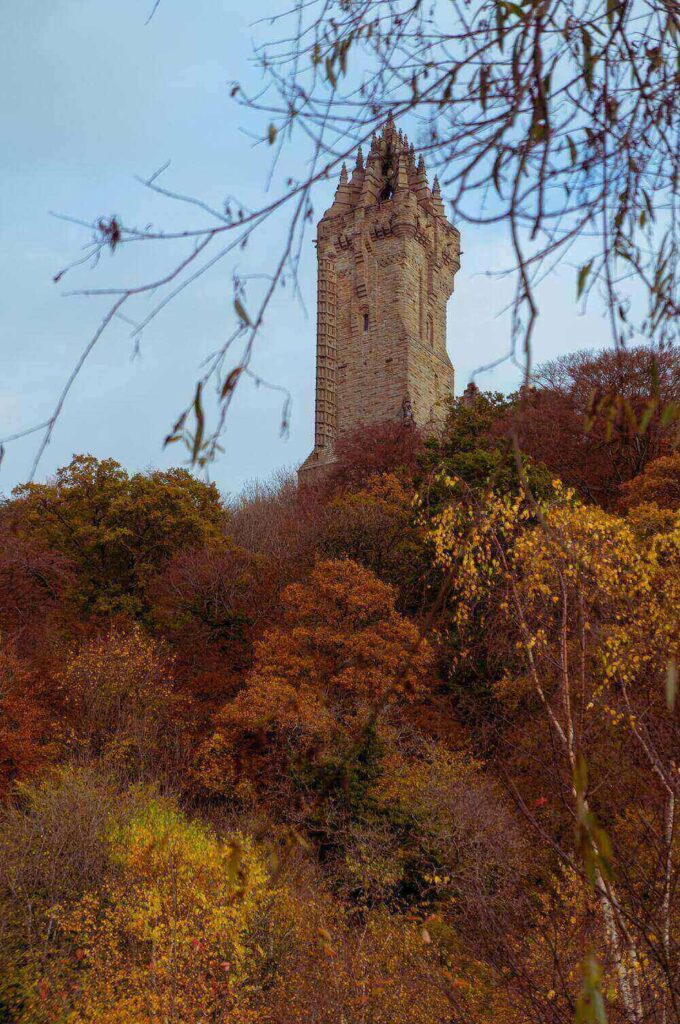
Located atop the 250-foot Abbey Craig, the Wallace Monument is an iconic structure dedicated to national hero Sir William Wallace.
Its was built in 1869 and adds a mix of historic charm in the surrounding stunning landscape.
Visitors can not only explore its rooms filled with interactive exhibits and historical artifacts, but you can climb to some of its parts closed to everyday circulation through special guided tours.
Every year, more and more tourists visit this majestic tower for its remarkable views across the Ochil Hills, Stirling Castle and the Trossachs!
Stop 3: Loch Lomond and Trossachs National Park
Scotland is not short of lochs, which non-Scots would consider to be lakes, and the first loch we will stop by on this itinerary is Loch Lomond, one of Scotland’s most iconic natural wonders.
Nestled at the foot of the Trossachs National Park, this expansive freshwater loch is surrounded by rugged hills, dense forests, and charming villages.
Take a stop here to admire the views or walk along the shores.
Head to the village of Luss for a bite to eat and a wander around the village, admiring the quaint stone cottages and a picturesque waterfront views.
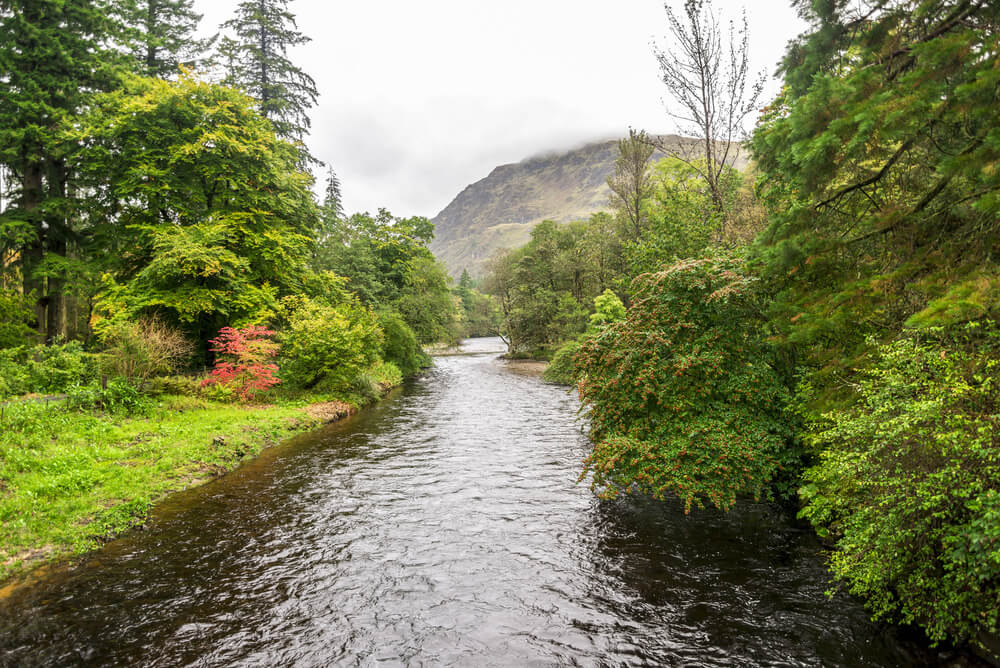
Surrounding the lake is Trossachs National Park, one of Scotland’s most beautiful regions bursting with history, activities, and amazing scenery.
The park was designated as a national park in 2002, though its cultural and historical roots date back much further.
It has attracted visitors since the 18th century with its plentiful walking trails. Some of the most popular are the West Highland Way, which is a more peaceful walk, or the strenuous trail hiking up the slopes of Ben Lomond for panoramic views.
Stop 4: Buachaille Etive Mor, Glencoe
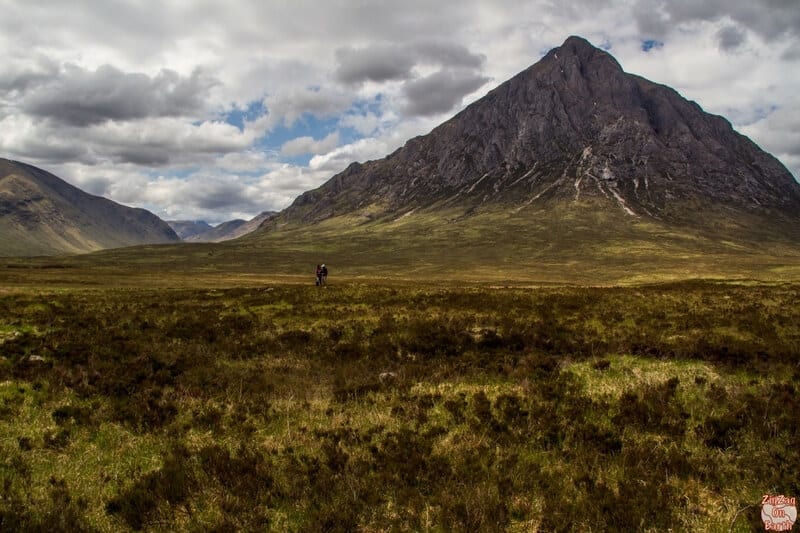
When you reach Glencoe, you will see the impressive Buachaille Etive Mor Mountain from far away (1022m).
This is probably the most photographed peak in Scotland because of its wonderful triangular shape.
As you drive towards it, the excitement builds up, as you know it is the beginning of a scenic valley.
And if you are a James Bond Movie fan, take the dead-end road at its foot called Glen Etive, to see some filming locations of the Skyfall movie!
I recommend staying the night in Glencoe. It’s quiet and picturesque, just the kind of setting you need for a quiet night’s sleep.
Stop 5: Etive Beag, Glencoe
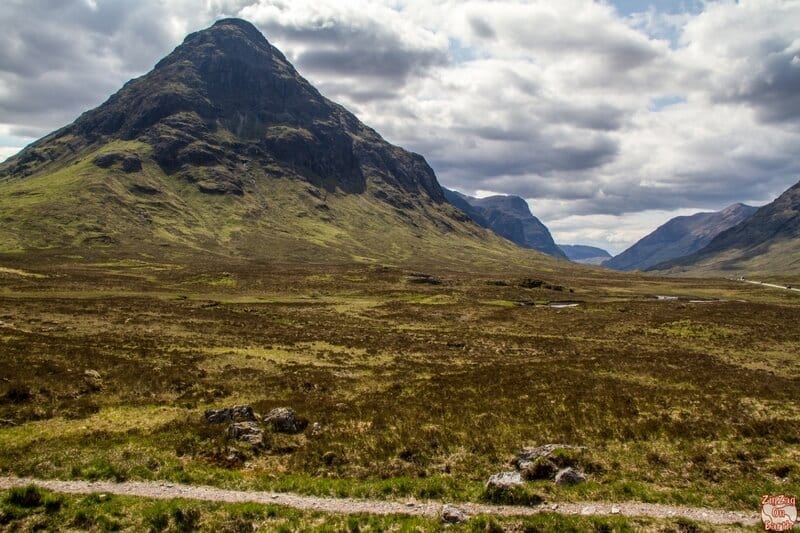
Wake up early and go for a walk up Etive Beag before leaving Glencoe. It’s not much further on from the last stop with a grandiose view of Glencoe.
I just wish I had the technology to take a 360° panorama for you.
From there you can see many of Glencoe’s summits. It’s the departure point for several hikes including Munro Bagging options – like they say in Scotland (meaning climbing peaks over 3000ft-915m).
This is a perfect place to stop for a while on your road trip if you like hiking.
Stop 6: Loch Atriochtan
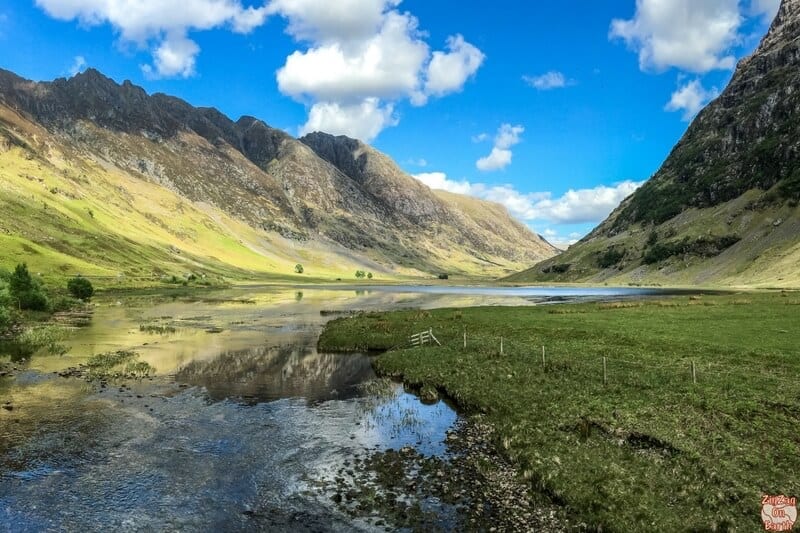
Also in Glencoe is Loch Atriochtan, a loch you may miss if you’re not looking out for it.
On the way from Etive Beag, drive by the famous Three Sisters viewpoint, which has views of Aonach Dubh, Beinn Fhada and Gearr Aonach mountains (also known as the Three Sisters), before stopping off for views of Loch Atriochtan.
At this point the valley is narrow and the small loch offers a great perspective of the mountain wall.
Stop 7: Fort William
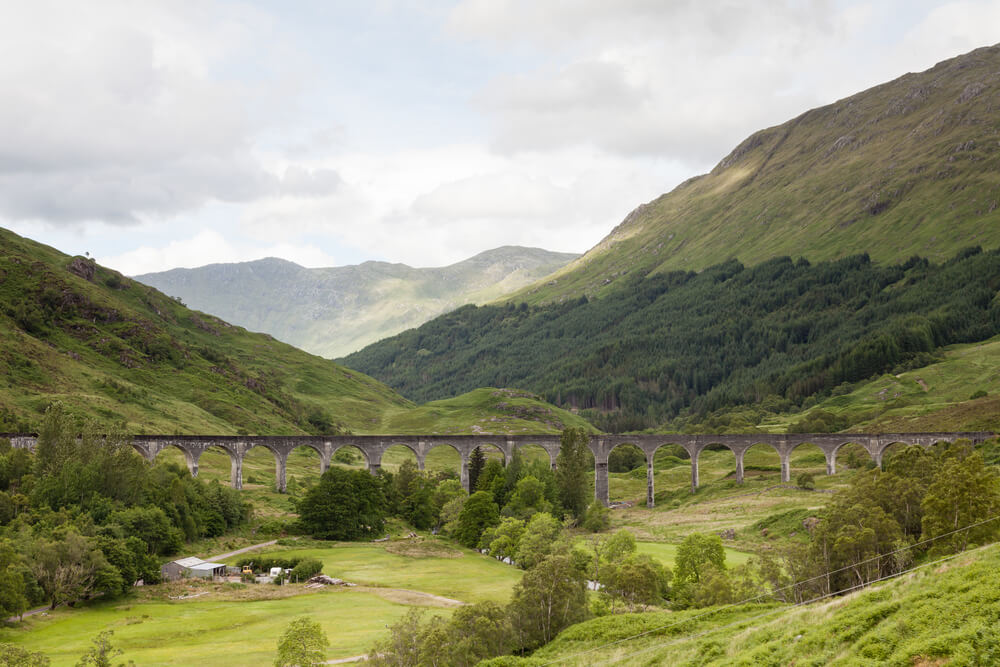
Fort William is an incredibly interesting and historical place. It’s located at the foothills of Ben Nevis, the Britain’s highest mountain.
The city dates back to around 1690, when explorers heading North started using Fort William as a port and military defence.
Nowadays, you can explore the fascinating history of the region by visiting the West Highland Museum, or go hiking in the nearby Lochaber Geopark.
You may also want to take the Hogwarts Express Jacobite steam train, which runs between Fort William and Mallaig over the Glenfinnan Viaduct.
Stop 8: Glen Shiel
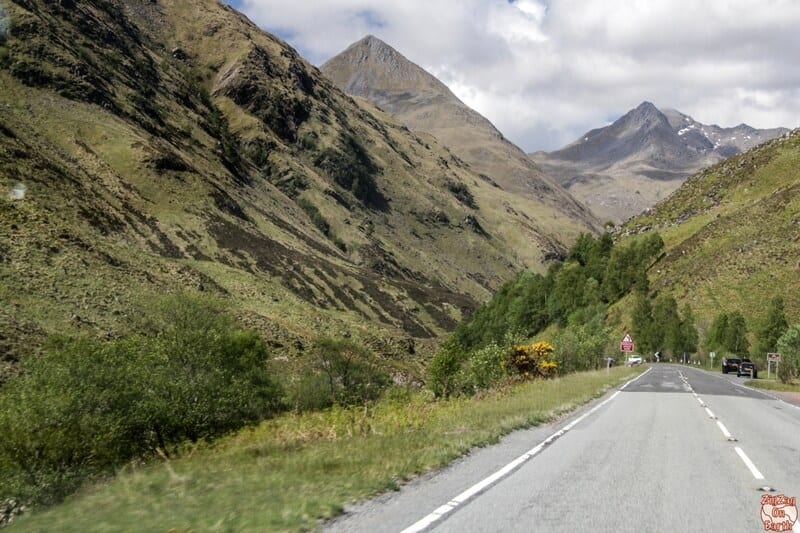
Further north, between Glencoe and the Isle of Skye, the main road takes you through Glen Shiel.
Here the road winds through the valley, following River Shiel and nested between towering mountains.
One of its most famous stops is the view of the Five Sisters of Kintail, a ridge with peaks rising to 3505ft (1068m).
You’ll also pass the iconic Glenfinnan Viaduct, the famous route to Hogwarts, as well as pass Loch Duich.
Stop 9: Eilean Donan Castle
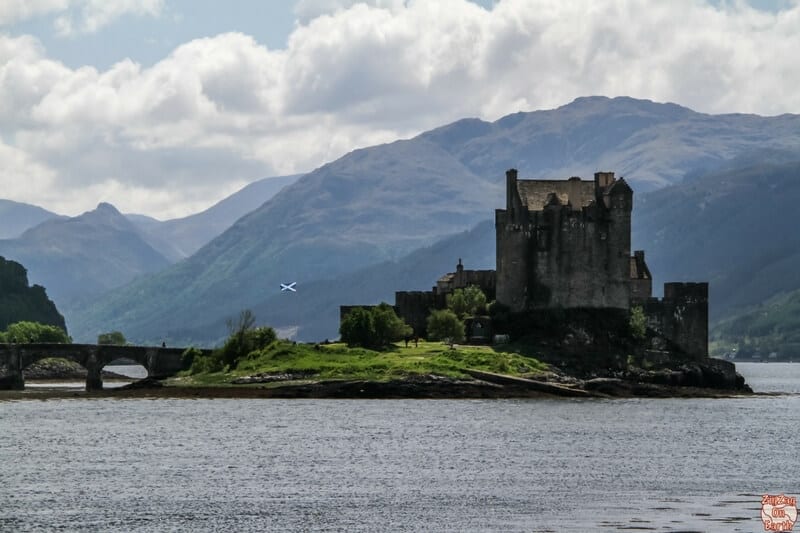
- Distance from last stop: 5.9 miles via A87
- Drive time: 10 minutes
- Notable places to eat: The Clachan
Our last stop before we reach the Isle of Sky is the famous Eilean Donan Castle.
Built on an islet from the 13th century, it was to offer protection against the Vikings at the meeting of 3 lochs.
Abandoned in the 18th century, a passionate man restored it in the early 19th century and it can still be visited today.
One of the best views is actually not at the main parking spot but from the other side of the bridge.
From there, you can capture the Castle, its bridge, and the stunning mountains of Glen Shiel in the background.
Stop 10: Old Man of Storr
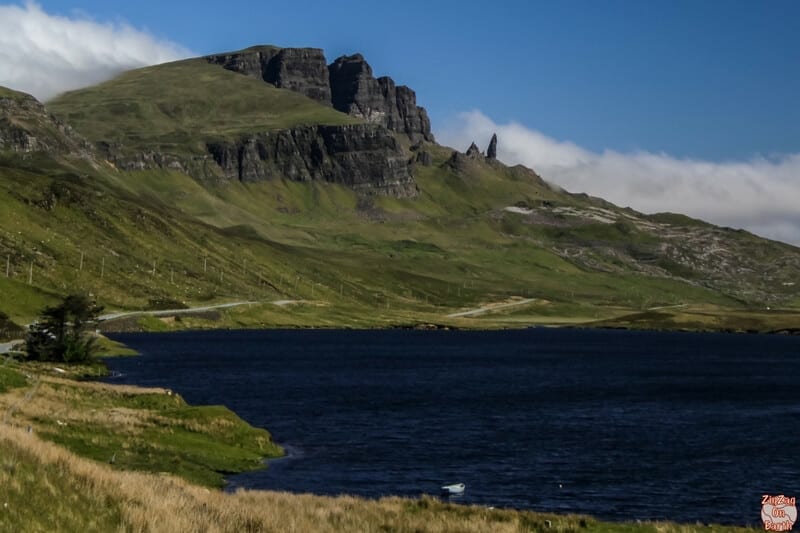
As you arrive at Kyle of Lochalsh, you drive on the Skye Bridge to access the Isle of Skye.
The road does not stop there though as the island is bigger than you think.
You still have to drive to the main town of Portree, which would be the ideal place to base yourself as you explore the Isle.
I recommend driving just a little North of Portree to admire the icon of the Isle of Skye, the Old Man of Storr.
Legend says that the 48m (160ft) high pinnacle is the thumb of a giant lying on the Earth.
Stop 11: Kilt Rock
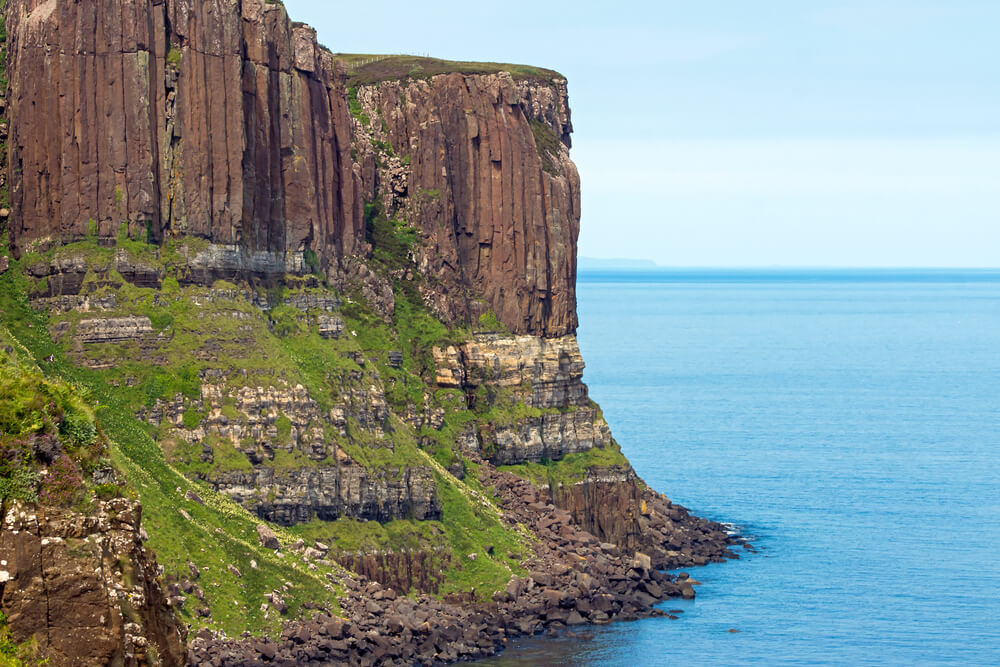
- Distance from last stop: 8.4 miles via A855
- Drive time: 10 minutes
Kilt Rock is one of the most famous rock formations in Scotland that stands at a mighty 190 feet high. This impressive sea stack rises from the waters off the Isle of Skye and forms part of the Trotternish Ridge.
Geologists believe that Kilt Rock was formed by both erosional processes and landslides occurring thousands of years ago.
It has since become one of Scotland’s iconic sights and is best known for its kaleidoscope of colourful lichen and seemingly endless waterfall dropping from the summit – which looks like a pleated kilt; hence its well-known name.
If you’re feeling brave enough you can even try rock climbing up its 300 foot deep fissure!
If you enjoy walking, head over to the nearby Quiraing, the summit of the summit of the Trotternish, for a bit of hiking.
Stop 12: Dunvegan Castle
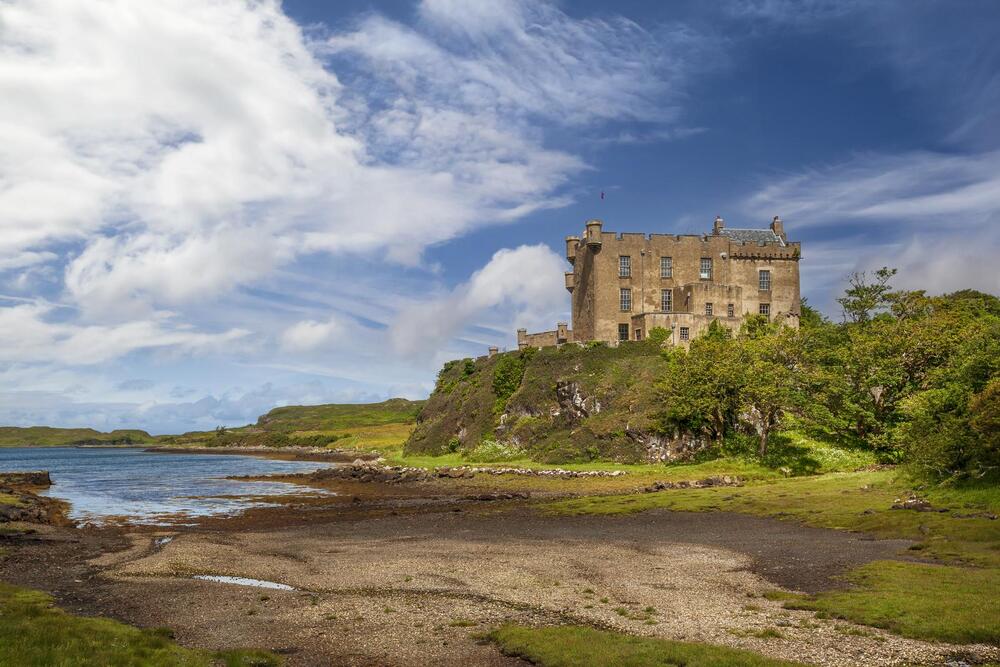
- Distance from last stop: 37.5 miles via A850 and A855
- Drive time: 1 hour
- Notable places to eat: Old School Restaurant
Dunvegan Castle is a fairytale-like castle has been standing for over 800 years and is the ancestral home of Clan MacLeod.
It’s located on the northeast side of the Isle of Skye and is one of the most historic and famous castles on the isle.
The castle gardens are equally as beautiful, with stunning native plants.
It’s also located on the coast, and you’ll find many sea caves nearby to explore. Or walk along cliff paths and take in the stunning views.
Isle of Skye back to Edinburgh
After spending some time exploring the Isle of Skye, you might be looking to return back to Edinburgh.
You can either go back the way you came, or you can take a loop detour around to see more of Scotland’s iconic landmarks, such as Loch Ness and Ben Nevis.
Here is our suggested route back…
Stop 13: Loch Ness
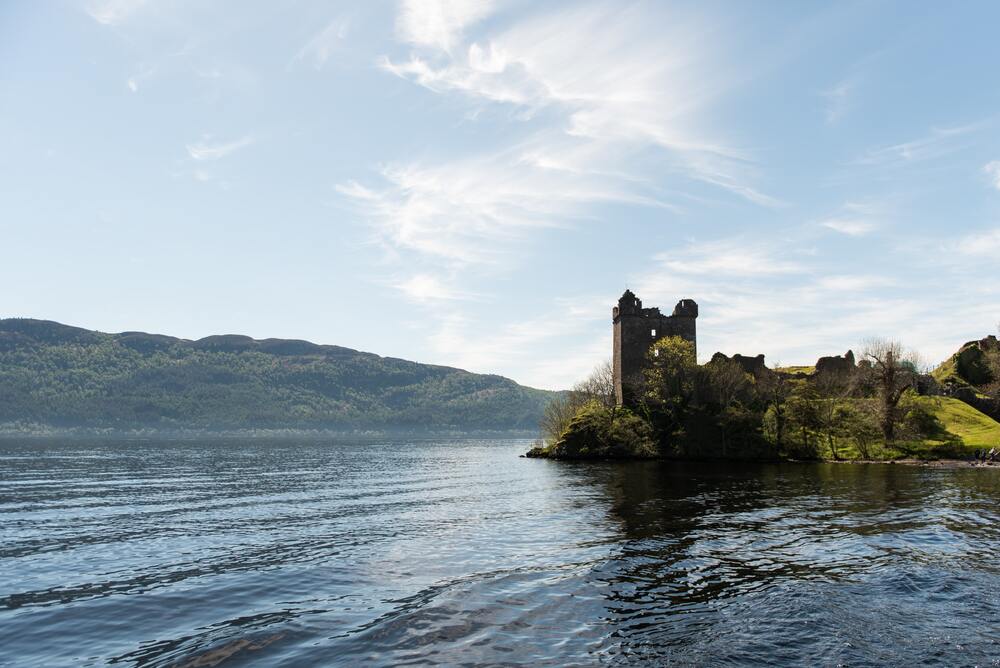
Scotland has lots of lochs, but none are as iconic and mysterious as Loch Ness.
Loch Ness is a large lake located in Inverness-shire and is known to be full of mystery and secrets.
If you visit Loch Ness, you’ll be able to take the Jacobite Cruise across the lake where you can learn about its intriguing past or you can visit Urqhuart Castle, which overlooks the mystic waters.
While there, take some time to enjoy the breathtaking views from all angles – whether from on land or from the tour boats.
Not only that, but there’s even a chance of spotting Nessie, the legendary monster!
Whether you’re a believer in of her existence or not, exploring Loch Ness should not be missed. Spend an entire day and night there to truly appreciate it.
Stop 14: Blair Castle and Cairngorms National Park
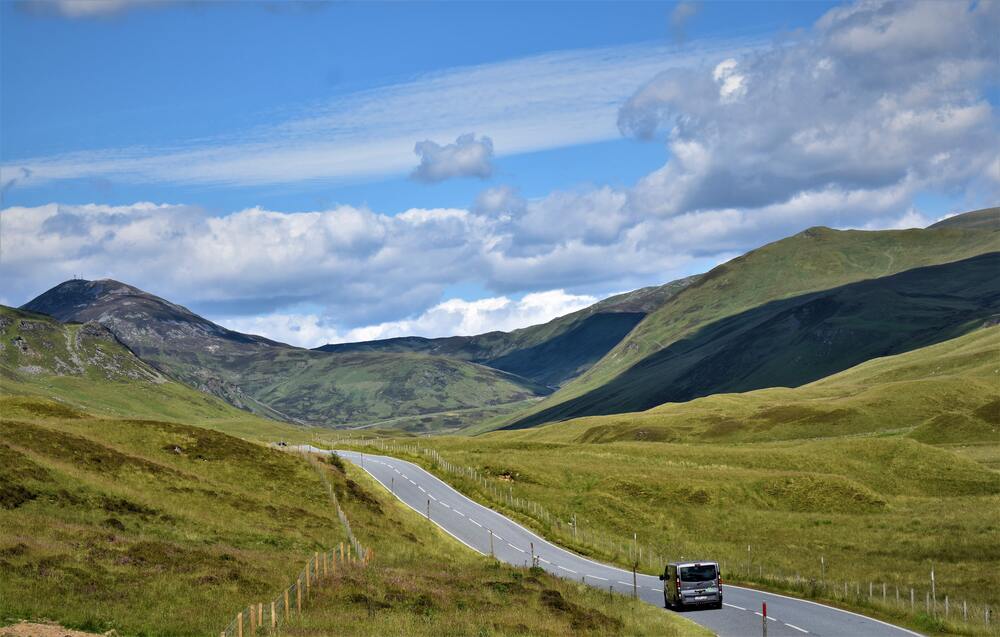
From Loch Ness back to Edinburgh, it’s easy to stop off at the Cairngorms National Park.
It’s the largest national park in the UK and is known for its beautiful landscape made up of moorland and lochs.
It’s also home to the Grampian Mountains, one of the most famous mountain passes in Scotland since it’s where Ben Nevis is located.
Don’t miss the Blair Castle, a gorgeous stately home and the ancestral residence of the Clan Murray, on the edge of the park.
It was used as the seat of the Duke of Atholl, though to the current Duke, Bruce Murray.
Stop 15: Scone Palace

- Distance from last stop: 35 miles via A9
- Drive time: 42 minutes
Did you know that scones are from Scotland? The first place these delicious sweet treats came from is unknown, but you can’t come to Scotland without trying one, and what better place than the aptly named Scone Palace?
This Grand Gothic stately home is the residence of home of the Earls of Mansfield, and is known for being the place where Scottish Kings were crowned.
It has a history dating back over 400 years, and some of the most beautiful manicured gardens with a maze. It has events on throughout the year, but it also has a delightful tea room where you can enjoy a Scottish dessert.
What a perfect and tranquil way to end a road trip!
Stop 16: Edinburgh
- Distance from last stop: 45 miles via M90
- Drive time: 1 hour 25 minutes
Finally, you’re back in Edinburgh. Drop off your rental car and head home!
Before You Go
So there you have it, that’s our itinerary for a road trip from Edinburgh to Isle of Skye and as you can see, there is so much to see along the way.
Whatever you do, be sure to allow plenty of time to visit each stop, and don’t rush it.
It’s a road trip that takes in the best of Scotland, so should be savored like a fine Scottish haggis.
Remember, peak season is between April and October, so you’ll find plenty of people doing a road trip this time of year – so make sure you book your rental car in advance.
More UK Travel Tips
Are you planning on visiting other parts of the UK? Then you may find the below resources useful…
Pin To Save It On Pinterest

